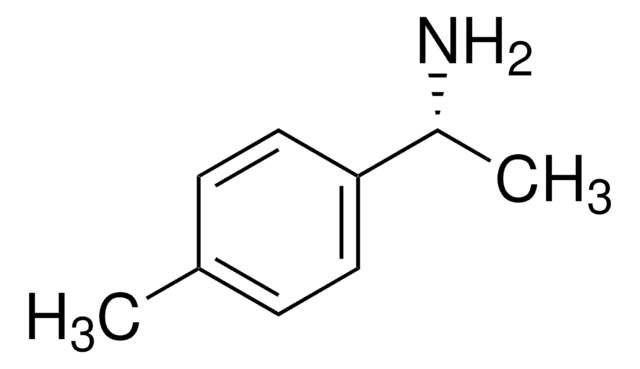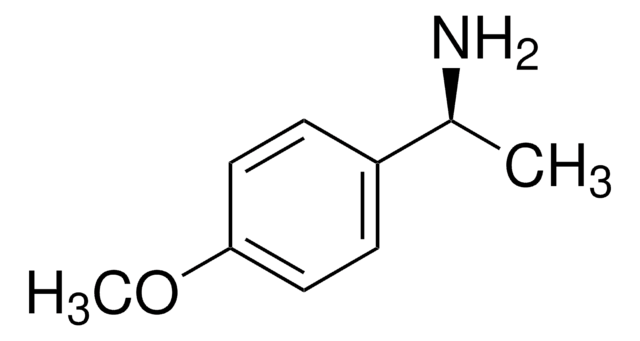726583
(S)-(−)-α-Methylbenzylamine
ChiPros®, produced by BASF, ≥99.0%
Synonym(s):
(S)-(-)-alpha-Methylbenzylamine, (S)-(−)-1-Phenylethylamine
About This Item
Recommended Products
grade
produced by BASF
vapor pressure
0.5 mmHg ( 20 °C)
Assay
≥99.0% (GC)
≥99.0%
form
liquid
optical purity
enantiomeric excess: ≥99.0%
refractive index
n20/D 1.526 (lit.)
bp
187 °C (lit.)
density
0.94 g/mL at 25 °C (lit.)
SMILES string
C[C@H](N)c1ccccc1
InChI
1S/C8H11N/c1-7(9)8-5-3-2-4-6-8/h2-7H,9H2,1H3/t7-/m0/s1
InChI key
RQEUFEKYXDPUSK-ZETCQYMHSA-N
Looking for similar products? Visit Product Comparison Guide
Application
- The first example of a diastereoselective thio-Ugi reaction: a new synthetic approach to chiral imidazole derivatives.: This research presents a novel diastereoselective thio-Ugi reaction, enabling the synthesis of chiral imidazole derivatives, which are essential in asymmetric synthesis and pharmaceutical intermediates (Gulevich et al., 2007).
- Synthesis and serotonin receptor affinities of a series of enantiomers of alpha-methyltryptamines: evidence for the binding conformation of tryptamines at serotonin 5-HT1B receptors.: This study investigates the synthesis and serotonin receptor affinities of alpha-methyltryptamine enantiomers, contributing to the understanding of chiral compounds in medicinal chemistry (Nichols et al., 1988).
Legal Information
Signal Word
Danger
Hazard Statements
Precautionary Statements
Hazard Classifications
Acute Tox. 3 Dermal - Acute Tox. 4 Oral - Skin Corr. 1B
Storage Class Code
6.1A - Combustible acute toxic Cat. 1 and 2 / very toxic hazardous materials
WGK
WGK 1
Flash Point(F)
158.0 °F - closed cup
Flash Point(C)
70 °C - closed cup
Regulatory Listings
Regulatory Listings are mainly provided for chemical products. Only limited information can be provided here for non-chemical products. No entry means none of the components are listed. It is the user’s obligation to ensure the safe and legal use of the product.
FSL
Group 4: Flammable liquids
Type 3 petroleums
Hazardous rank III
Water insoluble liquid
JAN Code
726583-100G:
726583-500G:
726583-BULK:
726583-VAR:
Certificates of Analysis (COA)
Search for Certificates of Analysis (COA) by entering the products Lot/Batch Number. Lot and Batch Numbers can be found on a product’s label following the words ‘Lot’ or ‘Batch’.
Already Own This Product?
Find documentation for the products that you have recently purchased in the Document Library.
Customers Also Viewed
Articles
Chiral amines play an important role in stereoselective organic synthesis. They are used directly as resolving agents, building blocks, or chiral auxiliaries.
Our team of scientists has experience in all areas of research including Life Science, Material Science, Chemical Synthesis, Chromatography, Analytical and many others.
Contact Technical Service










